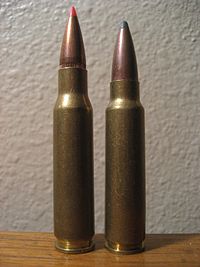
The .308 Winchester is a smokeless powder rimless bottlenecked rifle cartridge widely used for hunting, target shooting, police, military, and personal protection applications globally. It is similar but not identical to the 7.62×51mm NATO cartridge.

This is a list of firearm cartridges which have bullets of a caliber between 6 millimetres (0.236 in) and 6.99 millimetres (0.275 in).

The .32-20 Winchester, also known as .32 WCF , was the first small-game lever-action cartridge that Winchester produced. It was initially introduced as a black-powder cartridge in 1882 for small-game, varmint hunting, and deer. Colt produced a single-action revolver chambered for this cartridge a few years later.

The .44-40 Winchester, also known as .44 Winchester, .44 WCF, and .44 Largo was introduced in 1873 by the Winchester Repeating Arms Company. It was the first metallic centerfire cartridge manufactured by Winchester, and was promoted as the standard chambering for the new Winchester Model 1873 rifle. As both a rifle and a handgun caliber, the cartridge soon became widely popular, so much so that the Winchester Model 1873 rifle became known as "The gun that won the West."
The .221 Remington Fireball, often simply referred to as .221 Fireball, is a centerfire cartridge created by Remington Arms Company in 1963 as a special round for use in their experimental single-shot bolt-action pistol, the XP-100. A shortened version of the .222 Remington, it is popular as a varmint and small predator round while also finding use among target shooters. It has application as both a pistol round and as a rifle round.

The 7×57mm Mauser is a first-generation smokeless powder rimless bottlenecked rifle cartridge. It was developed by Paul Mauser of the Mauser company in 1892 and adopted as a military cartridge by Spain in 1893. It was subsequently adopted by several other countries as the standard military cartridge, and although now obsolete as a military cartridge, it remains in widespread international use as a sporting round. The 7×57 Mauser was a popular stalking cartridge and sporting rifles in this chambering were made by the famous British riflemakers, such as John Rigby, Holland and Holland, Westley Richards and others. British cartridge nomenclature designated caliber in inches, and the cartridge was known as the .275 bore after the measurement of a 7 mm rifle's bore across the lands.

The .30-40 Krag was a cartridge developed in the early 1890s to provide the U.S. armed forces with a smokeless powder cartridge suited for use with modern small-bore repeating rifles to be selected in the 1892 small arm trials. Since the cartridge it was replacing was the .45-70 Government, the new cartridge was considered small-bore at the time. The rifle ultimately selected for use by the Army was the Krag–Jørgensen, formally adopted as the M1892 Springfield. The cartridge was also used in the M1893, M1895, M1897, and M1900 Gatling guns.
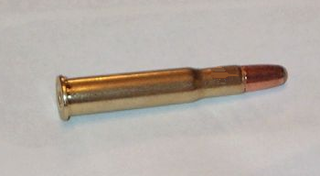
The .30-30 Winchester cartridge was first marketed for the Winchester Model 1894 lever-action rifle in 1895. The .30-30, as it is most commonly known, along with the .25-35 Winchester were offered that year as the United States' first small-bore sporting rifle cartridges designed for smokeless powder. Since its introduction, it has been surpassed by many cartridges in the long-range shooting attributes of speed, energy, and trajectory, yet remains in widespread use because of its practical effectiveness in forested hunting situations.
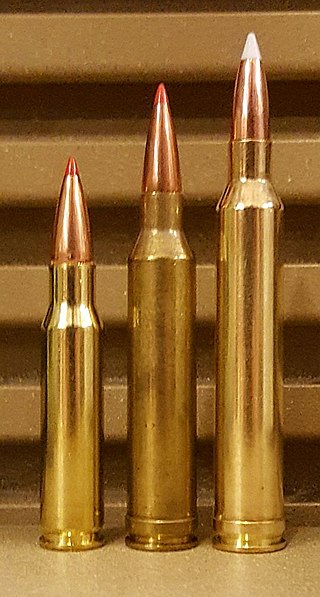
The 7mm Shooting Times Westerner, sometimes referred to as the 7mm STW, began as a wildcat rifle cartridge developed by Layne Simpson in 1979. It is an 8mm Remington Magnum case that has been "necked down" by 1 mm to accept 7 mm bullets. This cartridge is named after the magazine Shooting Times where Layne Simpson is a regular contributor.

The 7mm Remington Magnum rifle cartridge was introduced as a commercially available round in 1962, along with the new Remington Model 700 bolt-action rifle. It is a member of the belted magnum family that is directly derived from the venerable .375 H&H Magnum. The original purpose of the belted magnum concept taken from the .300 H&H Magnum and .375 H&H Magnum, was to provide precise headspace control, since the sloping shoulders, while easing cartridge extraction, were unsuitable for this purpose. Improved cartridge extraction reliability is desirable while hunting dangerous game, in particular when a fast follow-up shot is required. The 7mm Remington Magnum is based on the commercial .264 Winchester Magnum, .338 Winchester Magnum, and .458 Winchester Magnum, which were based on the same belted .300 H&H Magnum and .375 H&H Magnum cases, trimmed to nearly the same length as the .270 Weatherby Magnum.

The .303 Savage is a rimmed, .30 caliber rifle cartridge developed by the Savage Arms Company in 1894 which was designed as a short action cartridge for their Savage Model 1895 later 1899 hammerless lever-action rifle. The cartridge was designed for smokeless powder at a time when black-powder cartridges were still popular. The .303 Savage round was ballistically superior to the .30-30, but only marginally. The .303 Savage remained popular through the 1930s. Savage produced a half dozen loads for it. With its 190-grain loading, it was used on such animals as deer and moose.
The .300 H&H Magnum cartridge was introduced by the British company Holland & Holland as the Super-Thirty in June, 1925. The case was belted like the .375 H&H Magnum, and is based on the same case, as also is the .244 H&H Magnum. The belt is for headspace as the cases' shoulders have a narrow slope rather than an actual shoulder. More modern magnums continue this practice, but headspacing on the belt is not necessary with their more sharply angled shoulders. The cartridge was used by American shooter Ben Comfort to win the 1000-yard Wimbledon Cup Match at Camp Perry in 1935, and it was used again to win the international 1,000 yard competition in 1937. Winchester chambered the Model 70 in .300 Holland & Holland Magnum in 1937.

The .470 Nitro Express is a rifle cartridge developed by Joseph Lang in England for dangerous game hunting in Africa and India. This cartridge is used almost exclusively in double rifles. It is in wide use in the Southern and Central-East African region, favoured by hunting guides, primarily while out for hunting Cape buffalo and elephant.

The .257 Roberts, also known as .257 Bob, is a medium-powered .25 caliber rifle cartridge. It has been described as the best compromise between the low recoil and flat trajectory of smaller calibers such as the 5 mm and 6 mm, and has more energy, but is harder recoiling, similar to larger hunting calibers, such as the 7 mm and 7.62 mm.
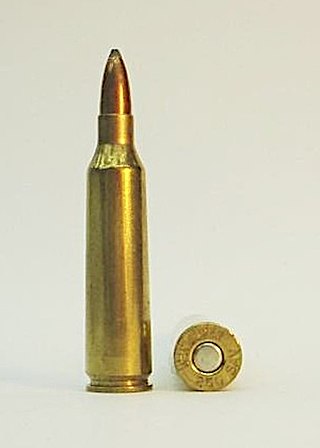
The .250-3000 Savage is a rifle cartridge created by Charles Newton in 1915. It was designed to be used in the Savage Model 99 hammerless lever action rifle. The name comes from its original manufacturer, Savage Arms, and the fact that the original load achieved a 3,000 ft/s (910 m/s) velocity with an 87 grain bullet.

The .307 Winchester cartridge was introduced by Winchester in 1982 to meet the demand of .300 Savage performance in a lever-action rifle equipped with a tubular magazine. It is nearly dimensionally identical to the more common .308 Winchester cartridge, the only differences being a rimmed base and thicker case walls.

The .284 Winchester is a firearm cartridge, introduced by Winchester in 1963.
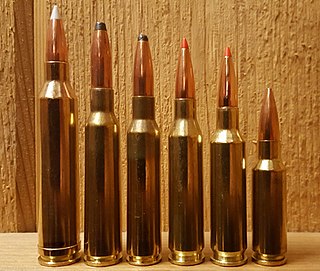
The 6.5mm Creedmoor (6.5×48 mm), designated 6.5 Creedmoor by SAAMI, 6.5 Creedmoor by the C.I.P. or 6.5 CM or 6.5 CRDMR for short, is a centerfire rifle cartridge introduced by Hornady in 2007. It was developed by Hornady senior ballistics scientist Dave Emary in partnership with Dennis DeMille, the vice-president of product development at Creedmoor Sports, hence the name. The cartridge is a necked-down modification of the .30 Thompson Center.

The .32-40 Ballard, also known as .32-40 Winchester is an American rifle cartridge.

The .32 Remington is an American rifle cartridge. A rimless, smokeless powder design, this cartridge was once considered to be suitable for game larger than deer and black bear. Similar contemporary cartridges include the rimmed .32 Winchester Special, a cartridge introduced by Winchester and offered as a chambering in Winchester's lever-action rifles.
